FRIDAY'S SCRIPT TIP:
END OF STORY!

In an interview in New York Magazine, Damon Lindelof says:
"The first 90 minutes of the movie are really an exercise in getting people to care about the people in the movie [so you can put] those people in jeopardy in the final set piece." Which seems to imply that the story is over before that final set piece... which is wrong in so many ways! And what is wrong with many of today's movies - including those written by Lindelof and pals. Whether it's the fault of the writers or the system, the result is the same.
Too many films from the summer of 2013 had the same issue - even though we know how the films will end - Superman will fight Zod and win - Act Three seems to missing the *journey* part... the *story* part. It's all rote. Just a big fight with no story left to tell. Did they correct this in the summer films of 2014? Nope. How about summer of 2023? Still a problem in some films! This is one of the reasons why the summer films have all seemed the same - when we get to the ending they *are* the same!
Once Act Three kicks in, the screenwriter has abdicated the story to the director who has abdicated the story to the FX guys... and they create a bunch of destruction that has no story. No journey. Without any story left, there is no real reason to watch the movie - except maybe the spectacle of destruction... and once you've destroyed some big Manhattan-like city, we've seen it and you need to show us a completely different spectacle. Destroying a city on film is used - like used toilet paper. You have to destroy something different... and in a different way. Every film needs to be different - and if there is no *story* left to make it individual, we're stuck finding brand new Act Threes.
In SECRETS OF ACTION SCREENWRITING's chapters on writing action sequences I stress that an action scene needs to be about character and story or it's trash. The same is true with that big action set piece in Act Three. If there is no story - it's just Superman fighting Zod for 30 minutes - it's trash. Even though your protagonist may have dealt with their emotional conflict at the beginning of Act Three, there are still a bunch of repercussions left over from before they got their sh*t together that still need to be resolved (along with the physical conflict). Plus, just because the protag may now realize that this is their world and they belong here... that doesn't mean that other people have accepted him or that resolving the physical conflict won't have some messy emotional issues. Your Act Three will still have story and emotions and character elements... or it's trash.

Also in SECRETS OF ACTION SCREEENWRITING one of the important techniques, even when the action scene is about character and story, is the use of *reversals* (complete with quote from the great Shane Black in the book) - story on a small scale... baby steps in the journey. A fight scene is not "they fight" - it's a story on a small scale. The outcome may be close to predetermined, but we still need the journey - where we worry that the protag may lose... or win at some expense. But these huge CGI battles tend to have no reversals, making them *dull action*. I think that's because these scenes end up being passed on to the Directors and CGI guys who aren't the *story experts*. "We'll have this gigantic fight scene where they destroy half the city!" and it's the same fight in every movie (often involving giant mechanical worms - why is that?). And because we *know* that the MAN OF STEEL will win the fight, it's boring. No twists, no big emotional moments, no tough decisions - just fightin'. You can safely leave the cinema when the fight begins because you won't miss anything. (Okay, you'll miss the outrage in MAN OF STEEL over millions of people probably killed as collateral damage.)
And that's the result of an Act Three without story - nothing to distract you from lapses in logic or problems with the pointless action itself. In MAN OF STEEL many people have complained about the millions who were no doubt killed in the destruction of New York City (er, I mean Metropolis). Defenders have told me that the city was evacuated - except we see Perry White and some other Daily Planet folks trying to escape... still in harms way. The Daily Planet people would be the first to escape - which means most of the city was still in those buildings that were destroyed. And once we get to the portion of this endless battle that takes place in Grand Central Station - it's still filled with people! This makes Superman kind of a mega-mass murderer for not taking this fight to someplace less populated. If there was some *story* left to tell, we wouldn't be so focused on the problems with the battle.
I know what you're thinking: "But Bill, MAN OF STEEL is a summer superhero movie! You can't expect Act Three to have story and character stuff!"
I'm so glad you thought that.
DONE RIGHT

Shall we look at another summer superhero movie and compare? How about 2002`s SPIDER-MAN (which I still think is the best in the series - even though the Villain's Plan and Villain are kind of weak... this series just seemed to slip with every installment until Spider-Man was disco dancing for some reason so they had to reboot it... and that hasn't worked out so well.) SPIDER-MAN's Act Three was a series of epic battles... that still have *plenty* of story to tell, and do it in a mostly exciting way.
Main squeeze Mary-Jane (Kirsten Dunst) has been kidnaped by Green Goblin (Willem Dafoe) - who dangles her from one hand and a tram car full of children in the other... dangling both hundreds of feet in the air! Spider-Man (Tobey Maguire) is given a choice by Green Goblin: "Let die the woman you love, or suffer the little children?" Then Green Goblin drops *both* at the same time. Unlike the passive battles in Act Three of MAN OF STEEL (yes, he's fighting; no he doesn't have to make any tough decisions except maybe for the moment where he has to save some token innocent people in Grand Central Station after thousands of other innocents have died a few minutes earlier), Spider-Man's battle is *active* - he must always be making really tough choices. "Make your choice Spider-Man, and see how a hero is rewarded." There is a crowd on the bridge *watching* this portion of the battle - what will Spider-Man do? Who will he choose to save?
You see how that's active and involving? How that is still story? The story will radically change if Spider-Man saves Mary Jane and allows the kids to die... and change in a different way if he saves the kids and Mary Jane dies. We do not know how this will resolve - even though we still know that Spider-Man will win this battle by the end. It's *the journey*!
"We are who we choose to be," Green Goblin says. "Choose!"
There's a great shot of Spider-Man's face, where Mary Jane is reflected in one eye and the tram of children in the other; as Spider-Man decides. A *visual* way to show him considering which he should do - and something that could easily have been in the screenplay.
And then Spider-Man makes his choice.
And saves Mary Jane!
But he's a smart superhero, and has a plan - he swings around with Mary Jane in his arms and grabs the tram cable - holding both hundreds of feet in the air. Not easy. And two things add to the suspense (and story) in this part of the scene - his web can not hold both the tram and Mary Jane and Spider-Man and is beginning to tear... so all of them may fall to their death; and Green Goblin is attacking! What will happen? Will Spider-Man's plan backfire and *all of them* will end up dying?

Okay, there's even more story at this point! There is a barge in the river that is coming to the rescue... if Spider-Man's web will hold out. But it's moving *slowly*. Will it make it there in time? Plus, Spider-Man tells Mary Jane she must climb down the tram cable to the tram so that he can safely lower her down to the barge with the kids... when the barge finally gets here. Mary Jane isn't sure she can do this... and might lose her grip and fall to her death. See how even though we are pretty sure Mary Jane won't be killed, this has us wondering if we might be wrong... and worrying that those kids who probably won't be in the sequel might die a horrible death in front of the crowd of onlookers on the bridge?
In this scene, Spider-Man's web *does* give out, Mary Jane almost falls to her death, Green Goblin continues attacking, Spider-Man has to let go of the tram full of kids for a moment... then catch them, Mary Jane *does* fall - but barely manages to grab the edge of the tram, the barge put-puts along ("He's not going to make it!"), and the crowd on the bridge takes a side - they throw debris at Green Goblin when he tries to kill Spider-Man. (This is a much better "public sides with Spidey" scene than the runaway train scene in SPIDER-MAN 2.) "You mess with one of us, you mess with all of us!" The barge finally gets there, Spider-Man lowers the tram full of kids and Mary Jane, and all is over...
Not.
Because Green Goblin slams Spider-Man into an old building, and the next part of this battle begins. This is the mano-a-mano fight portion, and these can become boring without great reversals... except this story still has plenty of story left. By the way - this fight scene *does* have plenty of great reversals - Spider-Man is taking a beating, and his last ditch effort to shoot a web at Green Goblin is thwarted. "You've spun your last web, Spider-Man," as the villain steps on his wrist. "Had you not been so selfish, your little girlfriend's death would have been quick and painless. But now that you've really pissed me off, I'm gonna finish her nice and slow." So this fight scene isn't just about Spider-Man and Green Goblin... but also about Mary Jane. It's mano-a-mano *with tangible stakes*.
But there is still story - still major plot twists. In the middle of this fight, Green Goblin's secret identity is revealed to Spider-Man. It's his best friend's Dad! "I've been like a father to you. Be a son to me now." Okay, how do you kill your best friend's Dad? Yeah, he's a super villain and killed some people... but he really has been a father figure to you. New information changes the scene. This is no longer just some hero vs. villain mano-a-mano fight, it's a huge messy decision where no matter what Spider-Man does it's wrong. Let the villain live? Can't do that in a movie. Kill your best friend's dad? Can't do that in a movie, either! So what does he do? What *can* he do? This is a great dilemma - and whatever his decision will change the course of the story - even though we are close to the end of the big Act Three fight scene!
Can't leave the cinema yet! Still plenty of story to go!

There's a great *moment* that comes here that resolves an emotional conflict from the beginning of this story - Peter Parker is an orphan raised by his Aunt May & Uncle Ben, but searching for a father figure.... and Osborne was that father figure for a while (after Peter contributed to the murder of his uncle). Now Osborne is asking that Peter be a son to him... and Peter declares, "I have a father, his name was Ben Parker." A big emotional moment - in the middle of the fight scene!
The final part of the battle between Spider-Man and Green Goblin is messy because this *is* his best friend's Dad... and he is forced to kill him (actually a "hoist by my own petard" where Spider-Man evades Goblin's giant sword-missile gizmo and it hits Green Goblin), but he villain's dying words are: "Peter, don't tell Harry." More story! A nice emotional twist *after* the villain has been vanquished!
Spider-Man gently takes his best friend's Dad back to his home and places him in his bed, so that he will have died as Mr. Osborne rather than the evil Green Goblin. When Harry (James Franco) - Peter Parker's best friend - enters the room! "What have you done!" And at Mr. Osborne's funeral, Harry tells Peter: "One day Spider-Man will pay. I swear on my father's grave Spider-Man will pay." Wow - still story at the tail end of the movie. Peter's best friend wants to kill Peter's alter ego. "Thank God for you, Peter. You're the only family I have left." The shot focuses on Peter's face - as he realizes this friendship just became insanely difficult. And then Peter hugs Harry - the man who has just vowed to kill him. Story, emotion, character. But wait, there's *more*!
"No matter what I do, no matter how hard I try, the ones I love will always be the ones who pay."
And now the kicker - Mary Jane, the woman that Peter Parker has secretly loved all along, comes to him and admits that when she almost died she realizes there was only one man that she really loved, "And it was you, Pete. There's only one man who has always been there fore me, who makes me feel that I'm more than I ever thought I could be, that I'm just me and that's okay. The truth is, I love you. I love you so much Peter." And she kisses him. And he realizes that if she is with him, she will be in danger... so he breaks *both* of their hearts by rejecting her. Telling her will always be there for her, but only as a friend. And walks away.
But wait, there's more!
Mary Jane (who once smooched Spider-Man) touches her lips after he walks away, then looks at him... wondering why that kiss is so familiar. So we have changes in the story throughout the entire Act Three battle and right up until the very last shot of the film. Plus *huge* emotional moments - *in* the Act Three battle and in that last shot. Could anyone in the audience have guessed that when the hero gets the girl at the end he would *dump her*? That's story that keeps going until the very end. The journey doesn't stop until the movie is over.
BACK TO LINDELOF

This tip began with that Lindelof interview, so let's look at Act Three of WORLD WAR Z, which he was brought in to write. The film was finished, and I guess test audiences gave it a fail, so they brought Lindelof in to write a new end that was shot to replace the old end. My "civilian" friends (not in the industry - warehouse guys) said they completely left it open for a sequel and asked me if this was gonna be a trilogy or something. That kind of plays to Lindelof's issues about resolving the conflict and tying up the loose ends before that final Fade Out. He still seems to have issues there, but I think his Act Three is pretty damned good... because he *does* focus on the characters and story.
The original Act Three was a giant war against the zombies in Russia... which was probably mostly story and character free. Lindelof's Act Three takes place in a World Health Organization Laboratory in Cornwall, UK... where our protagonist and a small group of scientists have to cross to the infected side of the laboratory to grab a virus that might make humans "invisible" to zombies (as "rotten meat"). One of the fun casting gags in this sequence is Peter Capaldi as the WHO doctor... who now plays Dr. Who. But the tension filled sequence is our hero Brad Pitt and a couple of others sneaking into zombie infested territory and trying not to be caught and bit. Act Three becomes more personal, and more about a series of tasks that need to be done in order to get the virus which may save mankind. Small things like accidentally making a noise that alerts the zombies becomes a pivotal part of the scene. It succeeds in turning a large event into something personal.
For some reason, movies today have thrown away the journey completely (or they are under the mistaken impression that giant CGI battles are story) and you can grab your coat at the beginning of the big end fight and leave - because you know how it will turn out and there won't be any story stuff. No more journey left! Just 30 minutes of pointless destruction before that inevitable ending.
Once the journey comes to an end, the story is over... and your screenplay should be over. (Though sometimes there's a *brief* scene or two of "falling action" where the world returns to a peaceful state.) Act Three is not supposed to be the Endless CGI Fight Scene Act, it's the *resolution* act - where all of the problems that have been growing since page 1 are dealt with one-by-one... and that should not be easy. Make sure you still have story and emotional problems and plot twists and big decisions until the very end of your story. Because once we have run out of that story-fuel? The journey is over!
BRAND NEW!
How Do I do That?

101 SCREENWRITING ANSWERS Blue Book!
New to screenwriting? You probably have questions! How do I get an Agent? How do I write a phone conversation? Do I need a Mentor? What’s does VO and OC and OS mean? What is proper screenplay format? Should I use a pen name? Do I need to movie to Hollywood? What’s the difference between a Producer and a Production Manager, and which should I sell my script to? How do I write a Text Message? Should I Copyright or WGA register my script? Can I Direct or Star? How do I write an Improvised scene? Overcoming Writer’s Block? How do I write a Sex Scene? And many many more! This book has the answers to the 101 Most Asked Questions from new screenwriters! Everything you need to know to begin writing your screenplay!
All of the answers you need to know, from a working professional screenwriter with 20 produced films and a new movie made for a major streaming service in 2023!
Only $4.99
NEW!!!
Can You Make It bigger?

BLOCKBUSTERS (and BEACH READS) Blue Book!
Writing something EPIC?
Over 500 Pages, ONLY : $4.99!
Thinking about writing a big Disaster Movie? An Historical Epic? An Epic Adventure Film? Or maybe you like Gladiator Movies? This book looks at writing Blockbusters and those Big Fat Beach Read novels - anything epic! Usng movies like JAWS, POSEIDON ADVENTURE, LAWRENCE OF ARABIA, THE GUNS OF NAVARONE, and those MARVEL and FAST & FURIOUS flicks as examples. What *is* a Blockbuster? 107 years of Blockbuster history! Blockbuster Characters. Blockbuster Story Types! Why modern Blockbusters are soap operas! Social Issues in Blcokbusters? Big Emotions! Keeping All Of Those Characters Distinctive! How to avoid the Big problems found in Big Movies and books! More! If you are writing a Big Event Movie or a Big Fat Novel, there are tips and techniques to help you!
Only $4.99
NEW!!
All About Endings!
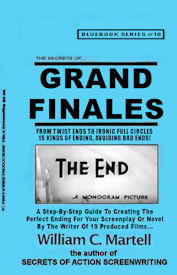
GRAND FINALES Blue Book!
The Perfect Ending For Your Story!
The First Ten Pages Of Your Screenplay Are Critical,
But What About The Last 10 Pages?
Creating the perfect ending to your story! This 100,000 word book shows you how to end your story with a bang, rather than a whimper. Everything from Resolution Order to Act Three Tools to Happy or Sad Endings? to How The Beginning Of Your Story Has Clues To The Ending (in case you were having trouble figuring out how the story should end) to Falling Action to How To Avoid Bad Endings to Writing The Perfect Twist Ending to Setting Up Sequels & Series to Emotional Resolutions to How To Write Post Credit Sequences to Avoiding Deus Ex Machinas, to 20 Different Types Of Ends (and how to write them) and much more! Everything about endings for your screenplay or novel!
Only$4.99
BRAND NEW
All About LOGLINES, TREATMENTS, and PITCHING!

LOGLINES, TREATMENTS, and PITCHING! Blue Book!
Distilling Your Screenplay!
Loglines, Treatments, Pitching, Look Books, Pitch Decks, One Pagers, Rip-O-Matics?
You have written a brilliant 110 page screenplay, but how do you get anyone to read it? You need to distill it down into some form of verbal moonshine or story rocket fuel that will ignite that bored development executive or manager or agent and get them to request your screenplay. But how do you shrink those 110 pages into a 25 word logline or a 2 minute elevator pitch or a one page synopsis or a short paragraph? This 100,000 word book shows you how! Everything you need to know! From common logline mistakes (and how to solve them) to how your pitch can reveal story problems to the 4 types of pitches!
272 pages - ONLY $4.99!
NEW: WRITE IT: FILM IT!

Making Your Own Movie?
Writing An Indie Film?
Writing A Low Budget Genre Script To Sell?
Writing A Made For TV Holiday Movie?
You will be writing for BUDGET. On a standard spec screenplay, you don’t have to think about budget, but these types of screenplays writing with budget in mind is critical!
If you are making your own movie, budget, is even more important - and you need to think about budget *before* you write your screenplay... or you will end up with a script that you can’t afford to make (or is a struggle to make). Everyone is making their own films these days, and even if you have done it before there are lots of great techniques in this book to get more money on screen - for less money! You can make a film that looks like it cost millions for pocket change.
344 pages - SALE:: $7.99!
NEW!

THE MISSION IMPOSSIBLE MOVIES
NEW: Updates On Films 7 & 8 Casting!
All Six Movies analyzed! All of the mission tapes, all of the “that’s impossible!” set pieces and stunts, the cons and capers - and how these scenes work, the twists and double crosses, the tension and suspense (and how to generate it), the concept of each film as a stand alone with a different director calling the shots (broken in the sixth film), the gadgets, the masks, the stories, the co-stars and team members (one team member has been in every film), the stunts Tom Cruise actually did (and the ones he didn’t), and so much more! Over 120,000 words of fun info!
THE MISSION IMPOSSIBLE MOVIES - 347 pages - Only $3.99 !
NO KINDLE REQUIRED! Get the *free* app (any device, except your Mr. Coffee) on the order page on Amazon!

BRAND NEW!
*** THE BOURNE MOVIES
All five "Bourne" movies (including "Legacy" and it's potential sequels) - what are the techniques used to keep the characters and scenes exciting and involving? Reinventing the thriller genre...
or following the "formula"? Five films - each with an interesting experiment! A detailed analysis of each
of the films, the way these thrillers work... as well as a complete list of box office and critical
statistics for each film. This book is great for writers, directors, and just fans of the series.
268 pages - Only $3.99
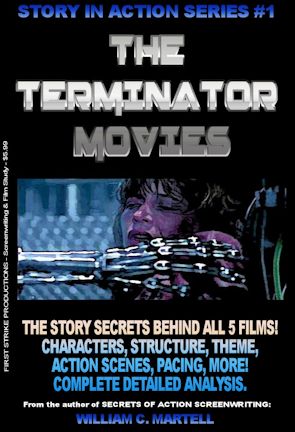
Over 240 pages!
*** THE TERMINATOR MOVIES *** - For Kindle!
He's back! The release of "Terminator: Dark Fate" is set to begin a new trilogy in
the Terminator story... 35 years after the first film was released. What draws us to these films about
a cybernetic organism from the future sent back in time? Why is there a new proposed trilogy every few
years? This book looks at all five Terminator movies from a story standpoint - what makes them work
(or not)? What are the techniques used to keep the characters and scenes exciting and involving? How
about those secret story details you may not have noticed? Containing a detailed analysis of each of
the five films so far, this book delves into the way these stories work... as well as a complete list of
box office and critical statistics for each film. This book is great for writers, directors, and just
fans of the series.
ONLY $3.99 - and no postage!
Tips FAQ

My New Script Secrets Newsletter!

NEW BOOKS!
BRAND NEW
OUTLINES & THE THEMATIC!
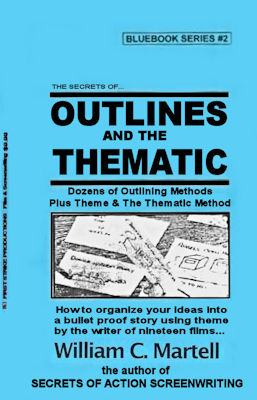
OUTLINES & THE THEMATIC Blue Book.
ARE YOUR SCENES IN THE RIGHT ORDER?
AND ARE THEY THE RIGHT SCENES?
Your story is like a road trip... but where are you going? What's the best route to get there? What are the best sights to see along the way? Just as you plan a vacation instead of just jump in the car and start driving, it's a good idea to plan your story. An artist does sketches before breaking out the oils, so why shouldn't a writer do the same? This Blue Book looks at various outlining methods used by professional screenwriters like Wesley Strick, Paul Schrader, John August, and others... as well as a guest chapter on novel outlines. Plus a whole section on the Thematic Method of generating scenes and characters and other elements that will be part of your outline. The three stages of writing are: Pre-writing, Writing, and Rewriting... this book looks at that first stage and how to use it to improve your screenplays and novels.
Only $4.99!
ALSO NEW!
DESCRIPTION & VOICE Blue Book!
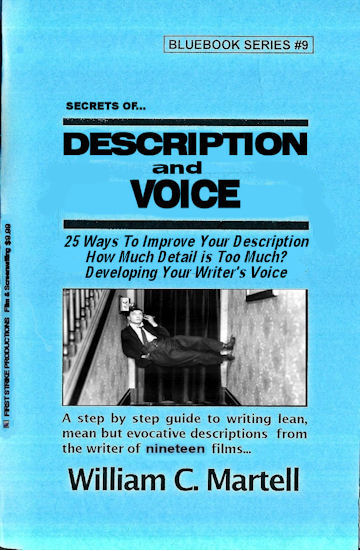
DESCRIPTION & VOICE Blue Book.
IS HALF OF YOUR STORY IN TROUBLE?
Most screenplays are about a 50/50 split between dialogue and description - which means your description is just as important as your dialogue. It just gets less press because the audience never sees it, the same reason why screenwriters get less press than movie stars. But your story will never get to the audience until readers and development executives read your script... so it is a very important factor. Until the movie is made the screenplay is the movie and must be just as exciting as the movie. So how do you make your screenplay exciting to read? Description is important in a novel as well, and the “audience” does read it... how do we write riveting description?
Only $4.99!
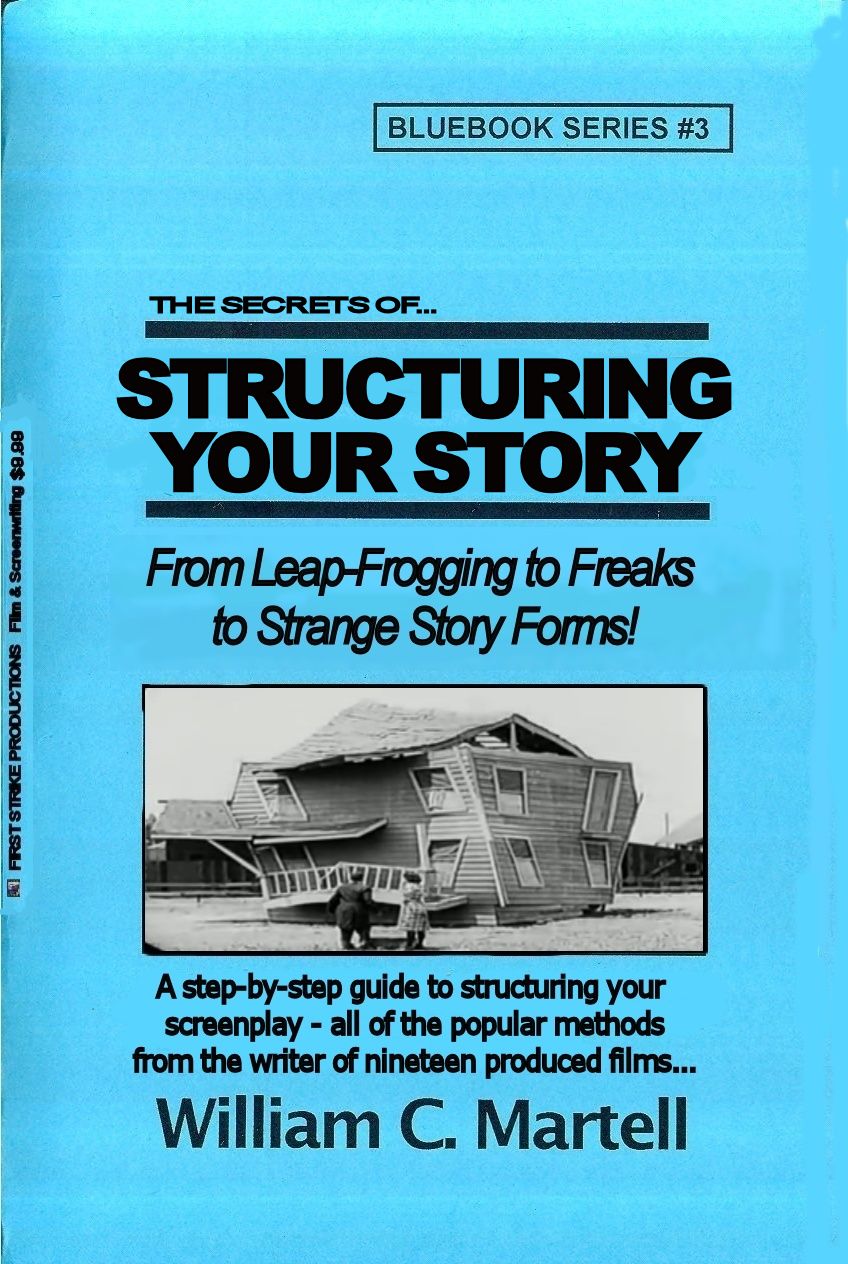
NEW AND HOT!
*** STRUCTURING YOUR STORY *** - For Kindle!
William Goldman says the most important single element of any screenplay is structure. It’s the skeleton under the flesh and blood of your story. Without it, you have a spineless, formless, mess... a slug! How do you make sure your structure is strong enough to support your story? How do you prevent your story from becoming a slug? This Blue Book explores different types of popular structures from the basic three act structure to more obscure methods like leap-frogging. We also look at structure as a verb as well as a noun, and techniques for structuring your story for maximum emotional impact. Most of the other books just look at *structure* and ignore the art of *structuring* your story. Techniques to make your story a page turner... instead of a slug!
Only $4.99 - and no postage!
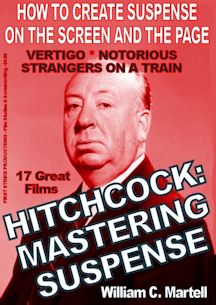
LEARN SUSPENSE FROM THE MASTER!
*** HITCHCOCK: MASTERING SUSPENSE *** - For Kindle!
Alfred Hitchcock, who directed 52 movies, was known as the *Master Of Suspense*; but what exactly is suspense and how can *we* master it? How does suspense work? How can *we* create “Hitchcockian” suspense scenes in our screenplays, novels, stories and films?
This book uses seventeen of Hitchcock’s films to show the difference between suspense and surprise, how to use “focus objects” to create suspense, the 20 iconic suspense scenes and situations, how plot twists work, using secrets for suspense, how to use Dread (the cousin of suspense) in horror stories, and dozens of other amazing storytelling lessons. From classics like “Strangers On A Train” and “The Birds” and “Vertigo” and “To Catch A Thief” to older films from the British period like “The 39 Steps” and “The Man Who Knew Too Much” to his hits from the silent era like “The Lodger” (about Jack The Ripper), we’ll look at all of the techniques to create suspense!
Only $5.99

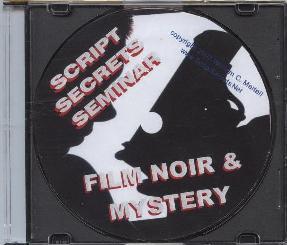
AUDIO CLASS!
NOIR & MYSTERY80 minute MP3 packed with information on writing Film Noir and Mystery scripts. Using examples from CHINATOWN to OUT OF THE PAST to DOUBLE INDEMNITY you'll learn how to create stories in this dark, twisted genre. How to plant clues, red herrings, suspects, victims, spider women, fallen heroes, the funhouse mirror world of noir supporting characters... and the origins of Film Noir in literature Noir dialogue and how noir endings are different than any other genre. All of the critical elements necessary to write in this critically popular genre.
The Noir & Mystery Class is only $15 (plus $5 S&H). First 20 on Limited Black Disk!
RECESSION SALE! $5 OFF!
IDEAS AND CREATIVITY - 80 minute MP3 packed with information. Tools to find ideas that are both personal *and* commercial. Hollywood wants scripts with High Concept stories... but not stupid scripts. Developing *intelligent* high concept ideas. How to turn your personal story into a blockbuster - or find your personal story in a high concept idea. Brainstorming and being creative. Ideas and Creativity is $10.00 (plus $5 S&H)
WRITING INDIES - Writing an Indie film? This class covers everything you need to know - from Central Locations to Confined Cameos. Using examples from SWINGERS, THE COOLER, STATION AGENT and others, this 80 minute MP3 is packed with information. How Indoe films challenge the audience (while mainstream films reassure the audience). Structures, using BOYS DON'T CRY, RUN LOLA RUN, HILARY & JACKIE, and others as example. Writing for a budget, writing for non-actors, getting the most production value out of your budget. Writing Indies is $10.00 (plus $5 S&H)
WRITING HORROR - The essentials of a horror screenplay - what do ROSEMARY'S BABY, NIGHT OF THE LIVING DEAD, THE EXORCIST, BRIDE OF FRANKENSTEIN, THE OTHERS and OPEN WATER have in common? This class will tell you! All of the critical elements necessary to write a script that scares the pants off the audience. Writing Horror is $10.00 (plus $5 S&H).
Click here for more information on CLASS MP3s!
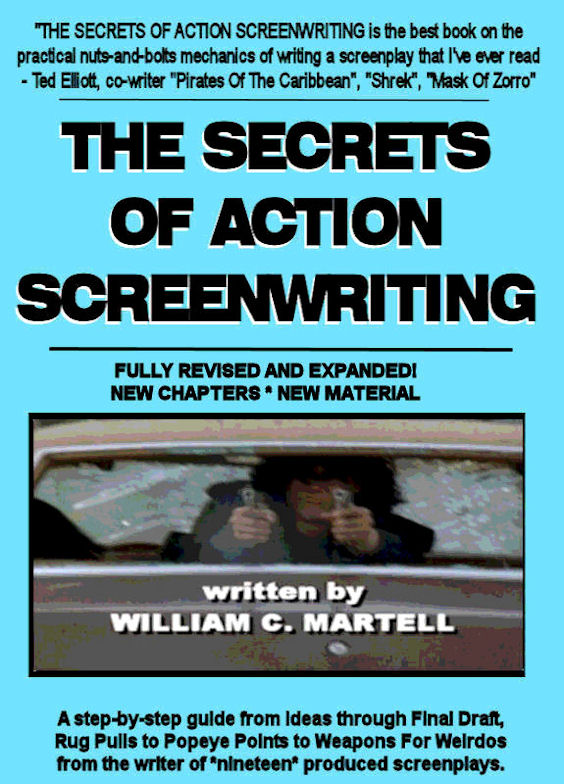
THE BOOK THAT STARTED IT ALL!
*** THE SECRETS OF ACTION SCREENWRITING *** - For Kindle!
*** THE SECRETS OF ACTION SCREENWRITING *** - For Nook!
Why pay $510 for a used version of the 240 page 2000 version that used to retail for $21.95? (check it out!) when
you can get the NEW EXPANDED VERSION - over 500 pages - for just $9.99? New chapters, New examples, New techniques!
"SECRETS OF ACTION SCREENWRITING is the
best book on the practical nuts-and-bolts mechanics of writing a screenplay I've ever read."
- Ted Elliott, co-writer of MASK OF ZORRO, SHREK, PIRATES OF THE CARIBBEAN and the sequels (with Terry Rossio). (ie; 4 of the top 20 Box Office Hits Of ALL TIME.)
Only $9.99 - and no postage!
READY TO BREAK IN?
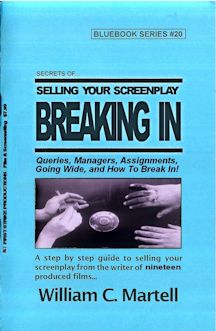
NEW!
*** BREAKING IN BLUE BOOK *** - For Kindle!
Should really be called the BUSINESS BLUE BOOK because it covers almost everything you will need to
know for your screenwriting career: from thinking like a producer and learning to speak their language,
to query letters and finding a manager or agent, to making connections (at home and in Hollywood) and
networking, to the different kinds of meetings you are will have at Studios, to the difference between
a producer and a studio, to landing an assignment at that meeting and what is required of you when you
are working under contract, to contracts and options and lawyers and... when to run from a deal!
Information you can use *now* to move your career forward! It's all here in the Biggest Blue Book yet!
Print version was 48 pages, Kindle version is over 400 pages!
$4.99 - and no postage!
NO KINDLE REQUIRED! Get the *free* app (any device, except your Mr. Coffee) on the order page on Amazon!
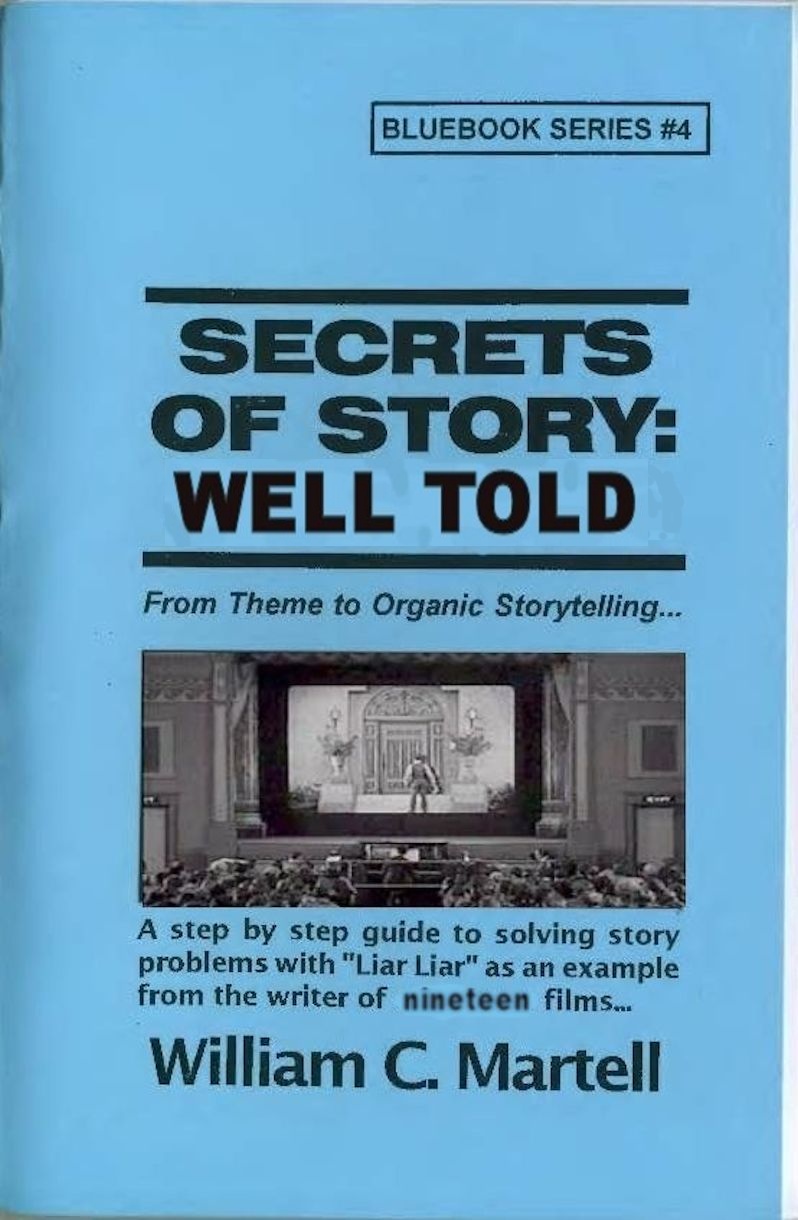
STORY: WELL TOLD!
*** STORY: WELL TOLD *** - For Kindle!
This book takes you step-by-step through the construction of a story... and how to tell a story well, why Story always starts with character... but ISN'T character, Breaking Your Story, Irony, Planting Information, Evolving Story, Leaving No Dramatic Stone Unturned, The Three Greek Unities, The Importance Of Stakes, The Thematic Method, and how to create personal stories with blockbuster potential. Ready to tell a story?
Print version was 48 pages, Kindle version is over 85,000 words - 251 pages!
Only $4.99 - and no postage!
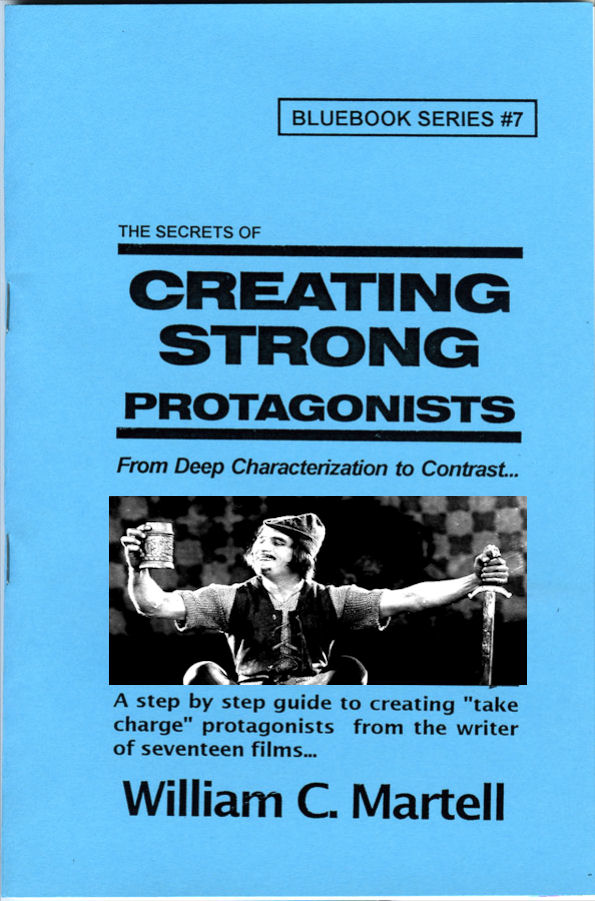
MOVIES ARE CHARACTERS!
*** CREATING STRONG PROTAGONISTS *** - For Kindle!
*** CREATING STRONG PROTAGONISTS *** - For Nook!
Expanded version with more ways to create interesting protagonists! A step-by-step guide to creating "take charge" protagonists. Screenplays are about characters in conflict... characters in emotional turmoil... Strong three dimensional protagonists who can find solutions to their problems in 110 pages. But how do you create characters like this? How do you turn words into flesh and blood? Character issues, Knowing Who Is The Boss, Tapping into YOUR fears, The Naked Character, Pulp Friction, Man With A Plan, Character Arcs, Avoiding Cliche People, Deep Characterization, Problem Protagonists, 12 Ways To Create Likable Protagonists (even if they are criminals), Active vs. Reactive, The Third Dimension In Character, Relationships, Ensemble Scripts, and much, much more. Print version is 48 pages, Kindle version is once again around 205 pages!
ONLY $4.99 - and no postage!
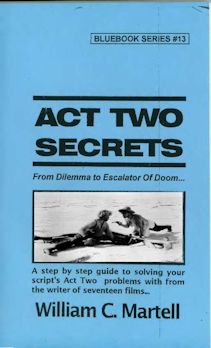
ACT TWO SOLUTIONS!
*** ACT TWO SECRETS *** - For Kindle!
Expanded version with more techniques to help you through the desert of Act Two! Subjects Include: What Is Act Two? Inside Moves, The 2 Ps: Purpose & Pacing, The 4Ds: Dilemma, Denial, Drama and Decision, Momentum, the Two Act Twos, Subplot Prisms, Deadlines, Drive, Levels Of Conflict, Escalation, When Act Two Begins and When Act Two Ends, Scene Order, Bite Sized Pieces, Common Act Two Issues, Plot Devices For Act Two, and dozens of others. Over 67,000 words (that’s well over 200 pages) of tools and techniques to get you through the desert of Act Two alive!
Print version was 48 pages, Kindle version is well over 200 pages!
ONLY $4.99 - and no postage!
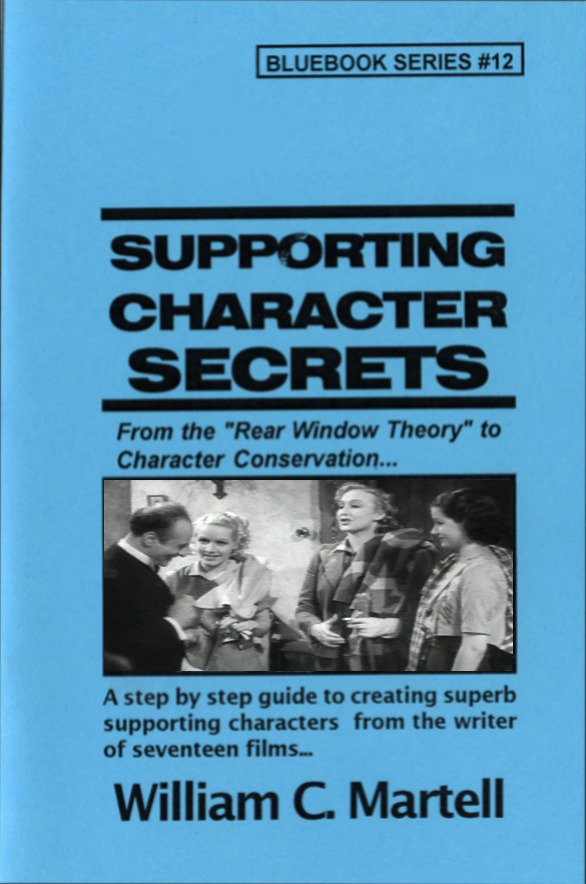
SUBPLOTS?
*** SUPPORTING CHARACTER SECRETS *** - For Kindle! (Exclusive)
Expanded version with more techniques to flesh out your Supporting Characters and make them individuals. Using the hit movie BRIDESMAIDS as well as other comedies like THE HANGOVER and TED and HIGH FIDELITY and
40 YEAR OLD VIRGIN and many other examples we look at ways to make your Supporting Characters come alive on the page.
Print version was 48 pages, Kindle version is around 170 pages!
ONLY $4.99 - and no postage!

ADVICE FROM 1920!
*** VINTAGE #1: HOW TO WRITE PHOTOPLAYS *** - For Kindle!
***
Screenwriting books have been around as long as films have. This series reprints vintage screenwriting books with a new introduction and history, plus new articles which look at how these lessons from almost 100 years ago apply to today’s screenplays. Anita Loos book is filled with information which still applies.
In addition to the full text of the original book, you get the full screenplay to Miss Loos' hit THE LOVE EXPERT, plus several new articles on the time period and women in Hollywood.
ONLY $2.99 - and no postage!
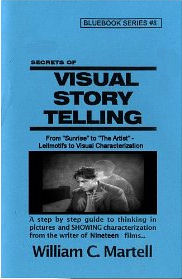
I WRITE PICTURES!
*** VISUAL STORYTELLING *** - For Kindle! (exclusive)
Show Don't Tell - but *how* do you do that? Here are techniques to tell stories visually! Using Oscar Winning Films and Oscar Nominated Films as our primary examples: from the first Best Picture Winner "Sunrise" (1927) to the Oscar Nominated "The Artist" (which takes place in 1927) with stops along the way Pixar's "Up" and Best Original Screenplay Winner "Breaking Away" (a small indie style drama - told visually) as well as "Witness" and other Oscar Winners as examples... plus RISE OF THE PLANET OF THE APES. Print version is 48 pages, Kindle version is over 200 pages!
ONLY $4.99 - and no postage!
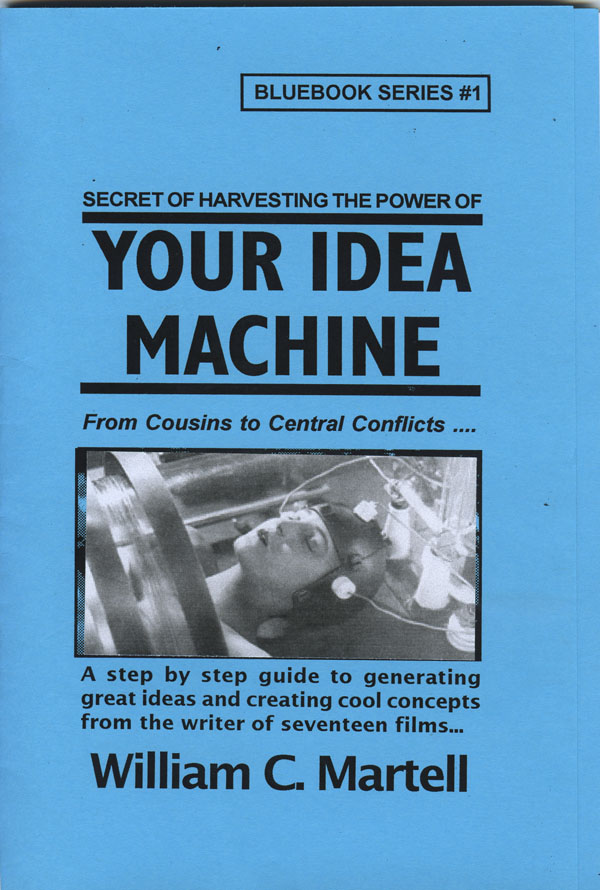
BEST SELLER!
*** YOUR IDEA MACHINE *** - For Kindle!
*** YOUR IDEA MACHINE *** - For Nook!
Expanded version with more ways to find great ideas! Your screenplay is going to begin with an idea. There are good ideas and bad ideas and commercial ideas and personal ideas. But where do you find ideas in the first place? This handbook explores different methods for finding or generating ideas, and combining those ideas into concepts that sell. The Idea Bank, Fifteen Places To Find Ideas, Good Ideas And Bad Ideas, Ideas From Locations And Elements, Keeping Track Of Your Ideas, Idea Theft - What Can You Do? Weird Ways To Connect Ideas, Combing Ideas To Create Concepts, High Concepts - What Are They? Creating The Killer Concept, Substitution - Lion Tamers & Hitmen, Creating Blockbuster Concepts, Magnification And The Matrix, Conflict Within Concept, Concepts With Visual Conflict, Avoiding Episodic Concepts, much more! Print version is 48 pages, Kindle version is over 175 pages!
Only $4.99 - and no postage!
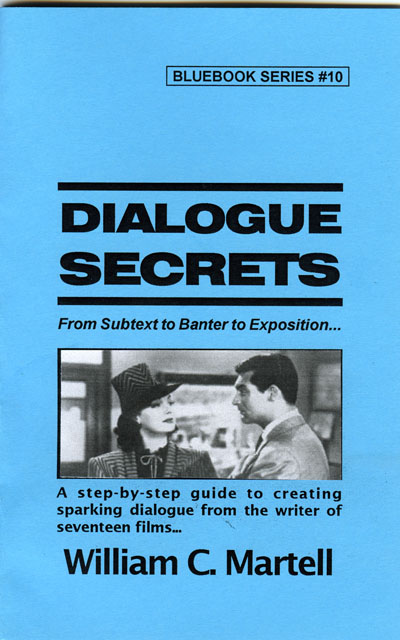
PRO DIALOGUE TECHNIQUES!
*** DIALOGUE SECRETS *** - For Kindle!
*** DIALOGUE SECRETS *** - For Nook!
Expanded version with more ways to create interesting dialogue! How to remove bad dialogue (and what *is* bad dialogue), First Hand Dialogue, Awful Exposition, Realism, 50 Professional Dialogue Techniques you can use *today*, Subtext, Subtitles, Humor, Sizzling Banter, *Anti-Dialogue*, Speeches, and more. Tools you can use to make your dialogue sizzle! Special sections that use dialogue examples from movies as diverse as "Bringing Up Baby", "Psycho", "Double Indemnity", "Notorious", the Oscar nominated "You Can Count On Me", "His Girl Friday", and many more! Print version is 48 pages, Kindle version is over 175 pages!
Only $4.99 - and no postage!

Use your creative energy to focus on the content; let Final Draft take care of the style. Final Draft is the number-one selling application specifically designed for writing movie scripts, television episodics and stage plays. Its ease-of-use and time-saving features have attracted writers for almost two decades positioning Final Draft as the Professional Screenwriters Choice. Final Draft power users include Academy, Emmy and BAFTA award winning writers like Oliver Stone, Tom Hanks, Alan Ball, J.J. Abrams, James Cameron and more.
* * * Buy It!

|

